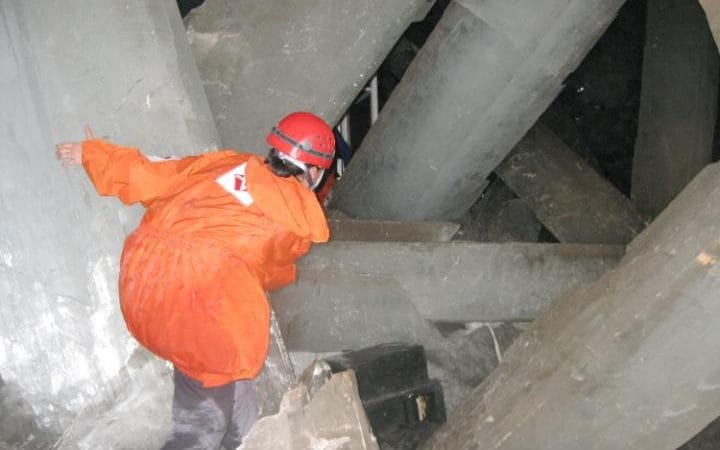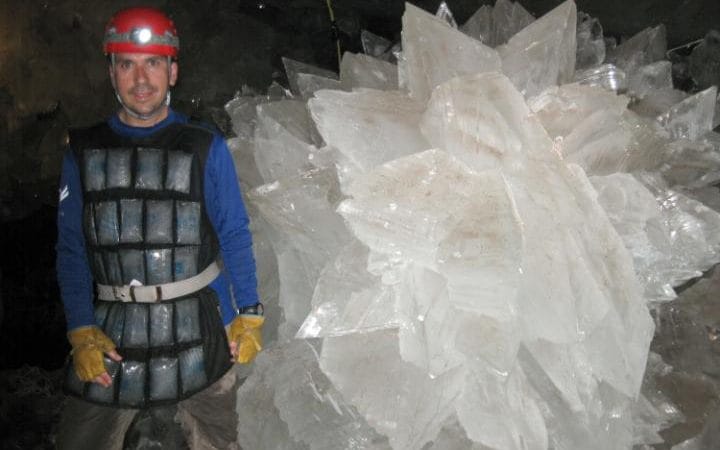You won’t believe what scientists found inside 50,000-year-old crystals in a Mexican Cave

People in special containment suits explore the massive beams of selenite inside the Cave of Crystals in Naica mine.
PHOTOGRAPH BY CARSTEN PETER, NATIONAL GEOGRAPHIC CREATIVE
Simply put fascinating. Biologists have discovered LIFE trapped inside 50,000-year-old crystals in a fairytale-like Mexican cave system. These bizarre, ancient microbes were found ‘dormant’ in the Naica caves and are believed to live off minerals such as iron and manganese.
Scientists discovered around 100 different organisms, which were mostly bacteria, inside crystals where they remained trapped for between 10,000 and 60,000 years. Interestingly, 90 percent had never been seen before.
The cave system, located in Naica Mexico, is referred to by experts as both Fairyland and hello, due to its incredible scenery yet ‘hellish’ temperatures.
The cave system is located above a massive pocket of volcanic magma and is geothermally heated.
Now, biologists have discovered LIFE trapped inside the crystals which are believed to be around 50,000 years old. The age of the microbes was determined by outside experts who basically looked at where the microbes were located inside the crystal, and how fast those crystals grow.
 Scientists from the New Mexico Institute of Mining and Technology made the 60,000 year-old discovery after venturing into caves that had been shut off from light and oxygen CREDIT: PENELOPE J BOSTON/PA
Scientists from the New Mexico Institute of Mining and Technology made the 60,000 year-old discovery after venturing into caves that had been shut off from light and oxygen CREDIT: PENELOPE J BOSTON/PA
These bizarre, ancient microbes were found ‘dormant’ in the Naica caves and are believed to live off minerals such as iron and manganese.
Some researchers, like Penelope Boston, head of NASA’s Astrobiology Institute described it as ‘super life’, as she presented the findings at the American Association for the Advancement of Science conference in Boston.
Even though the findings—which are a result of nine years of studies—were presented at a scientific conference, they have still not been published in a scientific journal and are still to be peer-reviewed.
“These organisms have been dormant but viable for geologically significant periods of time, and they can be released due to other geological processes,” says NASA Astrobiology Institute director Penelope Boston, who announced the find today at a meeting of the American Association for the Advancement of Science. “This has profound effects on how we try to understand the evolutionary history of microbial life on this planet.”
Experts plan to conduct more tests on the microbes which have been revived both in laboratories and on-site.
 Researcher Mario Corsalini stands by giant gypsum rosette crystals in the Naica mine in Chihuahua, Mexico CREDIT: PENELOPE J BOSTON/PA
Researcher Mario Corsalini stands by giant gypsum rosette crystals in the Naica mine in Chihuahua, Mexico CREDIT: PENELOPE J BOSTON/PA
According to Professor Boston, the curious life forms—40 different strains of microbes and viruses—are so unique that their nearest relatives are still 10 percent genetically different.
However, it is noteworthy to mention that this is NOT the oldest extreme life scientists have come across. Several years ago, experts published studies about microbes that are up to half a billion years old, and STILL alive. These organisms had remained trapped in ice and salt.
“They’re really showing us what our kind of life can do in terms of manipulating materials,” said Dr. Boston.
“These guys are living in an environment where there’s not organic food as we understand it. They’re an example at very high temperatures of organisms making their living essentially by munching down inorganic minerals and compounds. This is maybe the deep history of our life here.”
Describing working in the cave she said: “It was a transformative experience…it really felt strange. It was a very hard environment to work in, but tear-inducingly beautiful. It’s like being inside a geode.”
Thanks to: http://www.ancient-code.com

People in special containment suits explore the massive beams of selenite inside the Cave of Crystals in Naica mine.
PHOTOGRAPH BY CARSTEN PETER, NATIONAL GEOGRAPHIC CREATIVE
Simply put fascinating. Biologists have discovered LIFE trapped inside 50,000-year-old crystals in a fairytale-like Mexican cave system. These bizarre, ancient microbes were found ‘dormant’ in the Naica caves and are believed to live off minerals such as iron and manganese.
Scientists discovered around 100 different organisms, which were mostly bacteria, inside crystals where they remained trapped for between 10,000 and 60,000 years. Interestingly, 90 percent had never been seen before.
The cave system, located in Naica Mexico, is referred to by experts as both Fairyland and hello, due to its incredible scenery yet ‘hellish’ temperatures.
The cave system is located above a massive pocket of volcanic magma and is geothermally heated.
Now, biologists have discovered LIFE trapped inside the crystals which are believed to be around 50,000 years old. The age of the microbes was determined by outside experts who basically looked at where the microbes were located inside the crystal, and how fast those crystals grow.
 Scientists from the New Mexico Institute of Mining and Technology made the 60,000 year-old discovery after venturing into caves that had been shut off from light and oxygen CREDIT: PENELOPE J BOSTON/PA
Scientists from the New Mexico Institute of Mining and Technology made the 60,000 year-old discovery after venturing into caves that had been shut off from light and oxygen CREDIT: PENELOPE J BOSTON/PAThese bizarre, ancient microbes were found ‘dormant’ in the Naica caves and are believed to live off minerals such as iron and manganese.
Some researchers, like Penelope Boston, head of NASA’s Astrobiology Institute described it as ‘super life’, as she presented the findings at the American Association for the Advancement of Science conference in Boston.
Even though the findings—which are a result of nine years of studies—were presented at a scientific conference, they have still not been published in a scientific journal and are still to be peer-reviewed.
“These organisms have been dormant but viable for geologically significant periods of time, and they can be released due to other geological processes,” says NASA Astrobiology Institute director Penelope Boston, who announced the find today at a meeting of the American Association for the Advancement of Science. “This has profound effects on how we try to understand the evolutionary history of microbial life on this planet.”
Experts plan to conduct more tests on the microbes which have been revived both in laboratories and on-site.
 Researcher Mario Corsalini stands by giant gypsum rosette crystals in the Naica mine in Chihuahua, Mexico CREDIT: PENELOPE J BOSTON/PA
Researcher Mario Corsalini stands by giant gypsum rosette crystals in the Naica mine in Chihuahua, Mexico CREDIT: PENELOPE J BOSTON/PAAccording to Professor Boston, the curious life forms—40 different strains of microbes and viruses—are so unique that their nearest relatives are still 10 percent genetically different.
However, it is noteworthy to mention that this is NOT the oldest extreme life scientists have come across. Several years ago, experts published studies about microbes that are up to half a billion years old, and STILL alive. These organisms had remained trapped in ice and salt.
“They’re really showing us what our kind of life can do in terms of manipulating materials,” said Dr. Boston.
“These guys are living in an environment where there’s not organic food as we understand it. They’re an example at very high temperatures of organisms making their living essentially by munching down inorganic minerals and compounds. This is maybe the deep history of our life here.”
Describing working in the cave she said: “It was a transformative experience…it really felt strange. It was a very hard environment to work in, but tear-inducingly beautiful. It’s like being inside a geode.”
Thanks to: http://www.ancient-code.com






 Sat Mar 23, 2024 11:33 pm by globalturbo
Sat Mar 23, 2024 11:33 pm by globalturbo

